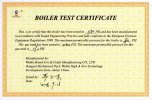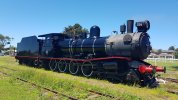Good set of notes - only thing missing is how the pressure gauge is determined as accurate.
The 7/8" Decauville I purchased had an obvious fault when it arrived (the gauge was stuck on 100psi) but others may not be as obvious.
I check my gauges by connecting a compressed air supply to the boiler which has an accurate gauge on the regulator - I can also test safety valves this way before a steam test (ie: set the air supply to 45psi and see if the safety lifts) - however this does not replace a steam test as detailed in the 16mm Society's notes!
A compressed air connection is also useful for setting valve timing!
And not all small boilers operate at 40psi - my Bowande Falk No.1's boiler is certified for 80psi (safety lifts at 70psi).
View attachment 344580
(Just spent almost a week sorting out its valve timing - it now runs properly in both directions).
Cheers,


